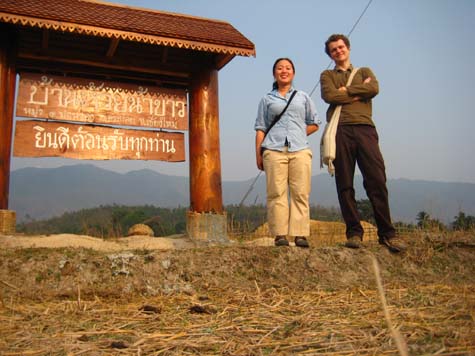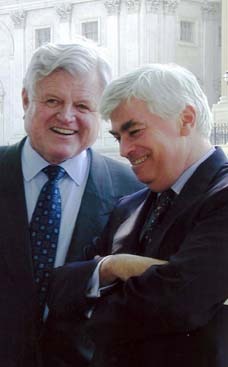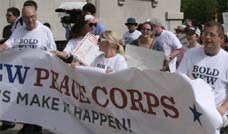
"My main reason for joining the Peace Corps, when I am honest with myself, was to learn Chinese," said Ben. "But we ended up getting placed in Thailand because you don't get to choose where you want to go with the Peace Corps. One does not really just ‘sign up' for the Peace Corps…it's actually a long, tedious process with a heavily screened and selected group that gets into the program, and it requires a big investment. We got our preference of Asia, but that's as much as you are allowed to narrow it down. We actually were originally assigned to Mongolia, but Lisa was not done with her master's degree yet so by the time she was finished we were assigned somewhere else. It worked out much better that way – the transition from Hawaii to Mongolia would have been very drastic. I guess you could say that I've got JFK to thank for my muddy legs," joked Ben about his Peace Corps experience. "The response of most Tuolumne County friends was the same when they heard I was going to Thailand with the Peace Corps: ‘Really? They're still doing that?'"
Ben and Lisa Fairfield served spent two years as Peace Corps Volunteers making Mud and Music in Thailand
Making Mud and Music in Thailand by Thomas Atkins
The Peace Corps: Two Years in a Thailand Hill Tribe
Caption: Ben and Lisa Fairfield in Thailand
Thousands of miles away in the mountains of northern Thailand, sits a small village on a hill. For two years this remote third-world setting became the new home of Ben Fairfield. Born and raised in the small town of Tuolumne, Ben, a 2000 Mother Lode Christian School graduate, was eager to see what the rest of the world had to offer and had a heart to help those in need. This combination prompted him, along with his wife, Lisa, to apply for the Peace Corp and in January of 2007 they found themselves beginning to take root in this foreign, muddy soil…
"I guess you could say that I've got JFK to thank for my muddy legs," joked Ben about his Peace Corps experience. "The response of most Tuolumne County friends was the same when they heard I was going to Thailand with the Peace Corps: ‘Really? They're still doing that?'"
The Peace Corps traces its roots and mission to 1960, when then Senator John F. Kennedy challenged students at the University of Michigan to serve their country in the cause of peace by living and working in developing countries. From that inspiration grew an agency of the federal government devoted to world peace and friendship, and the Peace Corps was officially established on March 1, 1961. Thanks to people like Ben and Lisa, nearly fifty years later, the Peace Corps is still going strong. So far, more than 195,000 Peace Corps Volunteers have served in 139 countries all over the globe working on issues that range from AIDS education to information technology to environmental preservation.
The mission of this worthy organization has three simple goals: Helping the people of interested countries in meeting their need for trained men and women, helping promote a better understanding of Americans on the part of the peoples served and helping promote a better understanding of other peoples on the part of Americans. Basically, it just boils down to the word "help", which goes very well with Ben's outgoing personality.
"I was ready to join the Peace Corps before I finished college," said Ben, 28. "My major was Global Studies, and I wanted nothing more than to go live abroad and experience life and culture first-hand. I had a naïve optimism that couldn't be quenched by worried relatives or realists."
Ben had his first taste of foreign soil during his last semester at Azusa Pacific University where he embarked on a self-directed study abroad program that he designed.
"The plan was to live in an orphanage in China for the summer and conduct research on that topic," he said. "I arrived in China to learn that there was, in fact, no orphanage. Instead I taught English in a small farming village and studied rural pollution – back before people took global warming and pollution seriously."
After graduating in 2004, Ben moved to Hawaii with his bride to be, Lisa, where she worked on her Masters while Ben worked in various capacities with the issue of homelessness with AmeriCorps.
"I did outreach by driving out to beach parks and jungles to walk through homeless camps in search of veterans," said Ben. "After a year working for AmeriCorps, I got a job working in the fundraising office of a local homeless shelter."With a desire to continue helping those in need, Ben and Lisa realized that there was no better opportunity to help than to volunteer with the Peace Corps, and the couple decided to apply. After Ben's experience in China, he had hopes of returning to that country.
"My main reason for joining the Peace Corps, when I am honest with myself, was to learn Chinese," said Ben. "But we ended up getting placed in Thailand because you don't get to choose where you want to go with the Peace Corps. One does not really just ‘sign up' for the Peace Corps…it's actually a long, tedious process with a heavily screened and selected group that gets into the program, and it requires a big investment. We got our preference of Asia, but that's as much as you are allowed to narrow it down. We actually were originally assigned to Mongolia, but Lisa was not done with her master's degree yet so by the time she was finished we were assigned somewhere else. It worked out much better that way – the transition from Hawaii to Mongolia would have been very drastic."
When the couple discovered that they were placed in Thailand instead of China, Ben adapted his goal to learning Thai and immersed himself into the culture, studying hard to learn the difficult language.
"My main goal, above all else, was to learn the language," he said. "Thai is not easy to learn with its five tones and cultural complexities built in, but it's a lot of fun to gain that independence that comes from fluency."Yet Ben did not let this language barrier get in the way of what he was in Thailand to do – help. His passion to help was evident during his time overseas and by the end of his two year experience Ben had accomplished and learned much more than the language. During his time he helped build five adobe houses, helped the mayor develop a trash collection program, worked with weaving groups and a chili paste group on product development (marketing and logo design), taught local housewives' groups how to make liquid soap, taught music at the local hill tribe dormitory, worked with a local rock band to produce a full-length album, and recorded and produced his own full-length album, Smileland.
Of course, when the couple first arrived at the Karen hill top village in Thailand, they had no idea what to expect or what they would be doing.
"The mountain village is home to about 1,000 people…kind of like Tuolumne," Ben joked. "It was the biggest Karen village in our sub-district."
The Karen, one of many Thai hill tribes, are easily distinguished by their clothing Ben explained.
"They traditionally weave thick cotton red, white, and black V-neck shirts and dresses," he said. "Up until about 35 years ago the Karen were nomadic and every two years they would build communities and homes from the ground up. They would live in huts with intricate leaf-thatched roofs to block the tropical heat and rains before moving over the next mountain ridge and starting another community. Nowadays one can find seemingly random, permanent establishments out in the middle of isolated forests because the government mandated that they settle down."
Ben and Lisa tried to settle down into their new lifestyle as well and spent the first few weeks of their time teaching English to local kids.
"We had one class with 18 students and one with 40, ranging in age from 4 to 12 year olds," said Ben. "It took some time to get used to."
Another thing Ben and Lisa had to get used to was the humid heat.
"It was unbelievably hot!" recalled Ben. "Tuolumne summers are nothing compared to Thai heat. It's oppressive. It's really all you can think about, and it makes you not want to get up or move or do anything. At night we were stewing in our own sweat. In the daytime we just wanted to sit in front of a fan and use as little energy as possible."
But it wasn't long before Ben found something that he wanted to put all of his energy into…mud. This cool, murky mixture of clay and water became his calling…and it all began after meeting a man by the name of Chanaphum.
"It took a full nine months of frustration, intense language study, Internet research, and scouring the tiny hill tribe village before I befriended Chanaphum," said Ben. "He was a local farmer who taught organic agriculture at an adobe house training center. I fell in love with the concept of adobe building and couldn't be swayed from the idea. I pushed it hard on everyone I met, and it was actually one of the first conversations I studied for. I didn't know how to get directions to the market, but I knew how to explain and troubleshoot the entire mud-house-making process in Thai."
The school where Chanaphum taught was home to 700 students, half of whom walked to school. At first this surprised Ben, but he soon adjusted to this foreign way of life.
"Many of them come from villages buried deep within the forests of surrounding hills where cars cannot travel, and they mostly come on foot," he said. "But they are used to walking. After awhile, seeing people walking everywhere, it stopped surprising me. As I'd be riding in a truck in the middle of nowhere, I'd see a pair of elderly Karen women emerge from a forest, carting monstrous bamboo baskets of firewood on their backs. I never knew where they were coming from or where they could possibly be going, but they seemed to be okay walking there. They are an incredible people, and can navigate the forests in their sleep."
Although the tribe people were experts of the forest and could construct huts with branches and leaves, not many had considered using the soil beneath their feet for construction purposes.
"In Thailand I encountered villages with no access roads and people building traditional nomadic housing in what were now static communities," said Ben. "They could not bring huge cement trucks to build concrete homes, their nomadic construction style no longer suited their situation, and Thailand had long ago outlawed logging. Meanwhile they were sitting on unutilized red dirt, perfect for adobe."
Although not a common practice where Ben was living, he discovered that adobe housing is not new to civilization, or to Thailand, and for thousands of years humans have constructed dwellings using dirt in every continent except Antarctica.
"There are many benefits of this age-old practice. The process is all natural, there are no transportation costs, local building materials are used, few tools are needed, the homes stay cool in the summer and are easy to heat in the winter, they require significantly less deforestation – both in terms of heating and construction – and best of all, it's free!" explained Ben. "The only materials needed are dirt, water, rice husk, and wooden brick mold. The post-construction materials include a door, window frames, and wooden roofing materials."Of course adobe houses can be a tough sell…especially in an area with a heavy monsoon season. Who would want a house made out of mud?
"Even many Americans, familiar with adobe, have a hard time being convinced of its advantages," said Ben. "Imagine explaining it to an indigenous group of people who have never heard of such a concept, never seen an adobe house… and never met an American. It's not an idea easily transplanted from American soil to there, especially given the monsoonal rains. A person would have to be crazy to attempt such a thing."
However, like the dirt and water mixed together to make the mud, Ben and Chanaphum were the perfect mix of "crazy".
"As an organic farmer, Chanaphum knew dirt," said Ben. "He knew its qualities and its capabilities. Dirt at his farm held water in rice paddies, its banks kept catfish ponds full, and pigs burrowed down into it to cool off. I realized that those same properties could be reapplied, with some explanation, to home construction."
It wasn't long before Ben found himself squishing in the red clay and began forming bricks…which intrigued Chanaphum.
"Chanaphum stopped by my house one evening and saw my stack of mud bricks," recalled Ben. "I had planned on building a small demonstration adobe hut in the yard. Realizing their potential, Chanaphum actually wanted to buy them from me. ‘Chanaphum,' I told him. ‘You're missing the whole point. It's dirt. It's free!'"
Plus, according to Ben, it's a pretty simple process.
"The process begins with mud," he explained. "First dig a pit. Then add 30 to 40 percent red dirt. The soil over there is very high in clay content and it can be like digging through rock. More than once I tore my hands open with a pick. The next ingredient is to add 60 to 70 percent black dirt (sandy soil) and then 10 to 15 percent rice husk. The rice husk keeps the bricks from cracking when drying in the sun. And the last ingredient is water."
Once all the ingredients are together…its time to get muddy.
"Stomping in the mud is the fun part," said Ben. "Mud needs to be mixed thoroughly, and the best way to make a house which people have been making for thousands of years is to try and do it the way they made them thousands of years ago – by foot. Foot-mixed adobe mud is compressed well, mixed well, and it's fun to do."
Once thoroughly mixed, the mixture is poured into a form, packed down and smoothed over with wet hands, and then the form is slowly lifted off. This process is repeated over and over and the bricks are left to dry for about 10 days.
"Once dried, the bricks are heavy and strong," said Ben. "We tried to dry them in the shade for the first week to prevent cracking, and after solidifying, we'd move them to the sun."
This simple recipe created an instant bond between Chanaphum and Ben and they spent the next several months together working in the mud…creating a mudslide of interest in the community
"We taught students to build a house at the school, Chanaphum built his own dwelling, the mayor asked for a hut at the government office, and the vice-mayor's daughter built a house on a hill," said Ben. "Then, once the dirt houses survived the four-month rainy season, the health clinic, hill tribe dormitory, one council member, and the district governor all wanted adobe. I was amazed. It's pretty impressive what red dirt and some crazy guys can do."
Ben started off simple. But, as with all things, practice improved his mud-making skills.
"The first weekend I made 18 adobe bricks; two weeks later I made an adobe oven," he said. "Then Chanaphum and I planned a classroom lesson for his students and taught the benefits, history, and process of adobe. The outcome would be that students would learn how to construct a strong, cheap, permanent, well-insulated, house using local materials, few tools, and no big trucks or cement. The house would serve as a model/educational center of eco-friendly and inexpensive construction."
Because adobe requires a pretty significant work force, Ben was thankful for the help of the students.
"Agriculture classroom time was used to dig, mix, and pour mud into brick molds, and I was often squishing around in the mud, accompanied by a 100 students," he said. "This situation reminded me of 4th grade at Mother Lode Christian School where I rebuilt Mission San Buenaventura for a project on California's adobe missions. I can still remember the smell of homemade Playdough coming out of the oven."
With this willing workforce Ben and his brick building army had about 600 bricks in four weeks. Usually Ben's completed houses were about 10 feet by 10 feet and 6 ½ feet high, requiring approximately 1,000 bricks six inches wide, 10 inches long and three inches high. However, the first trial hut only required about half.
"We were ready to start building once we had about 500 bricks," said Ben. "Unfortunately, building started on a day when I was not there to observe, and no one consulted me before building. The next time I saw the house two of the walls had been put up already, and not correctly. Structurally, it was a worrisome failure and was a prime example of how culture plays into projects. I was away for sports day, but a big school official was coming to town, so it HAD to be finished so that the officials could see this great project. It was built much quicker than planned and without foresight or planning, or consulting with the one person in the town who had built adobe before. But conceptually, this project was a success. We built a house from mud, and it looked pretty for the visiting officials. To me it was a structural nightmare that I feared wouldn't last through the rainy season, and I feared that if it failed it might turn my community off toward the construction method altogether."
Thankfully, it survived and the house became an icon of sustainability and hope. To give the house a little more character Ben used thick glass bottles for the windows, which bathed the inside of the house with golden light.
Ben's second house was even more impressive. It was during this project that Ben took Chanaphum to visit Jon Jandai's Adobe training center, the first Thai person to build adobe in Thailand.
"From this visit, Chanaphum's interest in adobe greatly increased," said Ben. "We also learned how they make tapioca plaster for the outer walls – for color and to make it waterproof. After stacking the bricks using mud mixture as mortar we'd coat the walls with a tapioca plaster, which was made by mixing tapioca starch and cold water. Then we'd boil the mixture until it turned opaque, add it to a mixture of sifted sand, let the mixture cool, and then we'd apply to the dry house walls with our hands."
By Ben's fourth adobe house he decided to test the theory that "adobe is so easy and fun to build that even children can do it", and embarked on a project involving no help from adults (with the exception of himself).
"This project was completed in one month – but we actually only put in five full work days," said Ben. "This time we did the roof in a traditional Karen hill tribe style. The Karen are known for using everything from the environment to their advantage, and they are especially famous for their roofs made of thatched teak leaves and bamboo. We applied this indigenous technique and tried to modify it into a conical roof. All beams and sections were bound with bamboo strips, and not one nail was used in the house's construction. Again, the goal was a 100 percent free house. And it worked!"
Nearing their two-year mark in Thailand, Ben completed his fifth and last adobe project, which is what he considered his first ‘real' adobe house project (with a purpose).
"It was requested by a local doctor who wanted a cheap/natural massage room at his health clinic," said Ben. "My job in this was in overseeing the adobe aspect of the building. The doctor hired "real" carpenters and professionals to draw up blueprints, set the foundation, and do all construction that was not adobe. It was a collaborative effort that I would not have been able to accomplish on my own. It turned out well, and the opening ceremony was officiated by the district governor, who also wanted to learn the process and construct at least 10 adobe resorts to promote tourism to the area."
Although Ben had far exceeded his goals in his adobe projects, when he wasn't busy working with mud on these huts, he admitted that an "average" day was nothing to write home about.
"Usually we would wake up with the chickens before the sun came up – it was the only mild weather of the day – and we'd go for a walk down to the river," he said. "After a cold bucket shower we'd make breakfast – usually rice, eggs, and tomatoes – and then I'd ride my bike to work where I'd stand under the fan for 20 minutes, sit at my desk and hang out with the government workers until I was ushered to some sort of community event. After lunch I'd come back to the office, have a snack of fruits, and then ride my bike home and take another cold bucket shower. For dinner we'd usually have rice and some sort of vegetable stir-fry. I would then read, crochet, or play music until going to bed around 9 p.m."
But whether it was an "average" day, or he was making mud, Ben always found the time to make some music. As a very talented musician, Ben discovered that one can make music out of just about anything, and while in Thailand he produced a local band's album as well as recorded his own.
"I wrote and recorded my own album in true Peace Corps style," he said. "I used only items that I had laying around the house and put together a CD, which in my opinion, sounds convincingly full."
With access to few instruments Ben improvised and made his album entirely with items costing less than five dollars. These included a thrift store guitar, a plastic panda reed piano, kitchen knives, sack of coins, a screen door, a wooden maraca, a bamboo broom, PVC pipe, a ceramic bowl, a maple syrup bottle, a cheap microphone, crumpled newspaper, a bamboo/coconut violin, an oven rack and of course his hands, feet and vocal chords. It's amazing what one can accomplish if they put their mind to something.
"Using an oven rack, a jar of coins, and a screen door I created a drum set," said Ben. "For a bass effect I dropped my guitar an octave and boosted the Equalizer. PVC pipes gave me horns for a pseudo-mariachi song, the high strings of my nylon guitar passed as a ukulele for a Hawaiian take on hill tribe living, and I used a knife to make a sound like a church bell. The album was recorded and designed entirely in my living room in our village. As a result, nearly every track has inevitable interruptions from birds, crickets, chickens, pigs, or other forces of natures…which I make no apology for."
The completed 13 track album is titled Smileland and provides 45 minutes of foot tapping original music. Considering the circumstances, it is very impressive and has a Jack Johnson feel to it. Since returning from the Peace Corps, Ben has completed a sequel to the album called Everything. With money raised from the album, he hopes to make a return trip to Thailand to see his Karen friends. Both of these albums can be heard and purchased at www.benjaminfairfield.com.
After showing his Smileland album to a local Karen rock band (students of Lisa's) the young rockers were excited to make an album of their own.
"They nearly salivated at the possibility of their own creation," recalled Ben. "I pretty much only had to show up. They knew exactly what they wanted to record. They were all kids that lived at our local dormitory/church, and their songs are in your typical high school punk-rock style, and are about Jesus and/or girls. The band is really talented and won first place in a contest of Karen bands held in Chiang Mai against eight other bands. The songs are not in Thai, but Karen, the local hill tribe language, so I couldn't give you a translation of the lyrics."
This project occupied the majority of Ben's evenings during his last two months in Thailand.
"I barely had time to shower before they would show up at our door wanting to record," he said. "I didn't have the best equipment for recording live takes of a full band, but it still sounds pretty good – if not a bit out of tune at times. It was draining because I had been building and moving tons of adobe bricks all day, but in the end we had a real product that all of us could be proud of. It's nice to leave something behind that I can point to and say, ‘We actually did that.'"
This album, which can also be heard on Ben's website, includes 12 songs and features special guest guitar soloists, keyboards, and singers.
"The full album is at the lulu store linked on the website, and is available for free. I highly recommend it," encouraged Ben.
While music and mud preoccupied most of his time, Ben has several other memories and highlights he will never forget during his two year Thailand adventure. These include harvesting rice, trekking to a local waterfall, and learning how to weave a Karen bag. But most of all it was the people he helped and the relationships he made.
"It's never easy to enter a new, close-knit community," said Ben. "But once you are accepted, the people become like family. I will never forget the weddings and funerals and the holidays. The holidays over there are amazing! For the New Year everyone throws water on each other for three days straight and the nearby Lahu hill tribe has seven days of non-stop dancing!"
One of Ben's most vivid memories was witnessing the results of a hunting trip in the jungle.
"I was at a nearby village one day when men began appearing out of the woods with rifles in hand, returning from a hunt," he recalled. "Their kill was an Asiatic Black Bear and six men were carrying dripping rice sacks which stained the already red soil. It was an interesting experience watching muddy children pet the severed head and women inspecting its feet and feeling its soft fuzz while the men snapped bones with dull knives and separated the flesh from the blobs of fat. Within a half hour, the portions had been doled out in mounds and each family carried home a bucket of flesh. I will never forget that."
Yet whether it was the bizarre or the mundane, Ben's time in Thailand will never be forgotten.
"The whole trip was quite an experience, and we will always cherish those two years," he said. "For those who have a heart to help, and want to experience cultures and see what else is out there, I highly recommend joining the Peace Corps."
Ben and Lisa are currently living in Honolulu, where Ben works at the YMCA of Honolulu with fundraising and Lisa is teaching ESL to international students preparing for American universities. Lisa will be applying for her PhD in communication, and Ben has applied for his masters in ethnomusicology at University of Hawaii. For more pictures visit: http://pcthailand.wetpaint.com/page/adobe+house. Also, visit sierramountaintimes.com or Benjaminfairfield.com for a fascinating true story written by Ben about a female village co-worker named Nok.












